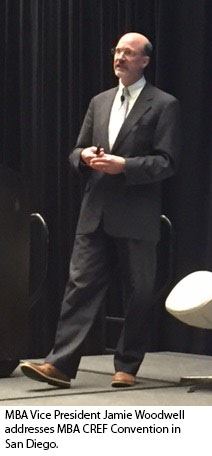
Commercial Real Estate Dynamics Changing
SAN DIEGO–Commercial real estate remains healthy going into 2018, but it dynamics are changing, says Mortgage Bankers Association Vice President of Commercial and Multifamily Research Jamie Woodwell.
“We were in a situation where a rising economic tide was floating all boats, but now there are different stories for different property types,” Woodwell said here this week at the MBA Commercial Real Estate Finance/Multifamily Housing Convention & Expo.
 MBA projects commercial and multifamily mortgage originations to decline slightly in 2018, ending the year at $549 billion, down 3% percent from 2017. MBA expects volumes to remain at roughly that level in 2019 as well; the forecast calls for mortgage banker originations of just multifamily mortgages at $248 billion in 2018, with total multifamily lending at $271 billion. After strong growth in recent years, multifamily lending is expected to hold roughly steady in 2019.
MBA projects commercial and multifamily mortgage originations to decline slightly in 2018, ending the year at $549 billion, down 3% percent from 2017. MBA expects volumes to remain at roughly that level in 2019 as well; the forecast calls for mortgage banker originations of just multifamily mortgages at $248 billion in 2018, with total multifamily lending at $271 billion. After strong growth in recent years, multifamily lending is expected to hold roughly steady in 2019.
Woodwell cited rising interest rates, slowing net operating income growth, pressure on capitalization rates and fewer loan maturities as factors that could hold markets back. “There is a strong mix of both headwinds and tailwinds in the commercial real estate finance markets right now,” he said. “Our sense is that for commercial and multifamily mortgage borrowing and lending, the net effect is likely to be close to a wash. “
At the same time, Woodward said continued economic growth, large amounts of investment capital looking for a home–and liking the looks of commercial real estate–and the recent tax reform legislation may all push the transaction markets forward.. “The magnitude and opposing impacts of some of these changes, however, raises the level of uncertainty,” he said.
For example, Woodwell noted a “tug-of-war” between supply and demand in the multifamily world. “On the demand side, there are many people looking to rent them, but on the supply side, there are the largest number under construction since the mid-1970s,” he said. “There is a lot of supply going out there to meet a lot of demand.”
The office sector is currently benefiting from solid long-term employment growth, Woodwell said, noting the unemployment rate is at its lowest level in years. But he said as recently as 2010, each employee averaged 225 square feet of office space. “Today, each employee only gets 150 square feet on average,” he said. “The growth of teleworking and office-sharing companies such as WeWork have made office use much, much more efficient.”
The retail sector’s troubles have dominated headlines recently, Woodwell noted. “Many of us have used Amazon in the past few days–perhaps even in the last 15 minutes,” he said. “We all know ecommerce has been growing, but in truth that’s driving stories more than reality. Yes, there have been shifts in demand, but consider one fundamental fact: if nine percent of retail sales are now made through ecommerce, that means 91 percent of retail sales are not made online. We’ve seen strong retail growth.”
Woodwell noted the industrial sector has benefitted from the contraction in bricks-and-mortar retail stores. “I like to say that what ecommerce taketh from retail, ecommerce giveth to industrial,” he said. “Industrial real estate in a lot of ways is now like multifamily; there is tons of demand and it’s an investor darling.”
The National Council of Real Estate Investment Fiduciaries tracks generally higher-quality properties owned by institutional investors, Woodwell noted. “And there’s a positive story there, too,” he said. “They are seeing long-run growth in net operating incomes, some contraction in apartments and retail, growth in the industrial sector and in central business district offices.”
Overall, 2017 was a very strong year for mortgage originations, Woodwell said. “You can expect that to tail off a bit this year, but it should be a relatively modest decline and we’ll likely see activity stay at these pretty high levels,” he said. “We’re not seeing the same pace of growth we used to see, but we are seeing growth. That’s pretty remarkable this late in the cycle. CRE is sort of like the Energizer Bunny–it keeps going and going.”
